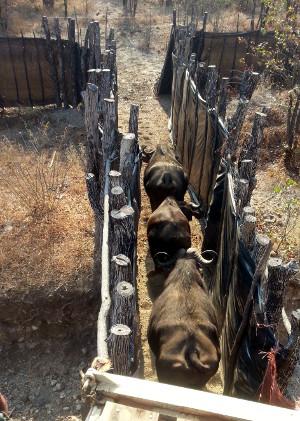Sidinda CAMPFIRE Wildlife Conservancy

Sidinda CAMPFIRE Wildlife Conservancy has received 100 buffalo from Victoria Falls National Park (managed by Wild Horizon). This follows successful capture and translocation of the animals on 27-28 August 2018 as part of the Command Wildlife programme, and funded under auspices of the Hwange Sanyati Biological Corridor (HSBC) project supported by the Global Environment Facility and the World Bank and coordinated by WWF Zimbabwe Country Office.
The Community Areas Management Programme for Indigenous Resources (CAMPFIRE) Association is the lead agency for the livelihoods improvement subcomponent of the project, and through this and other upcoming initiatives, it seeks to enhance livelihood security for vulnerable communities threatened by climate change, human and wildlife conflict and diminishing natural resources.
The operation was carried out by a local game capture company, African Wildlife Management and Conservation (AWMC), under the supervision of Hwange Rural District Council, Parks Ecologists and Rangers, as well as the Veterinary Services Department and security personnel. The buffalo are part of a donation of various species of plains game by the government of Zimbabwe, through the Parks and Wildlife Management Authority.
Like many other rural areas, Sidinda ward has suffered drought, water shortages, overgrazing, livestock diseases and human wildlife conflict, which in combination, have made conventional livelihoods less viable. This has led to increased pressures on natural resources and diminished support for conservation initiatives.
The translocation of game will help in establishing new economic flows into rural areas, enhance food security, and stem the over-exploitation of natural resources. Sidinda Ward is important in terms of wildlife conservation and the tourism industry, especially through sport hunting, as it has been a hunting area for most species on the Hwange District’s hunting quota. About three herds of elephants (approximately 100) are resident in the Ward.
The community identified the northern section of the Ward as the proposed exclusive wildlife area measuring approximately 205 km2. Resource mapping and zoning of the project area was done through a participatory process, and currently a 13km temporary release solar powered electric fence has been put up by a private Safari Operator, and within which a boma has been constructed to receive the animals. The Safari Operator is contracted by Hwange Rural District Council (RDC) on behalf of the community, and is assisting the community in managing the wildlife.
The restocking project entails the reintroduction of various wildlife species, and the development of a business plan to provide viable options for wildlife utilization, under a Public Private Community Partnership (PPCP). The project will play an important role in enhancing the employment of local people, and capacity building of the community is also being supported under the project.
The community will also benefit from future live animal sales, and meat production from legal harvesting of the wildlife. Other completed activities directly funded by the project include radio communication infrastructure, training of 14 game scouts, and establishment of the Sidinda Environment Subcommittee to support management of the project. Potential business ventures related to the restocking project include photographic safaris, diversified tourism products such as curio sales; water-based tourism, and other recreational experiences given that Sidinda Ward is located along the Zambezi River between Victoria Falls and Lake Kariba.
The spill-over effect of the restocking project includes upgrading of schools, water supply for crop production/gardening and for both livestock and wildlife, as well as other related project initiatives such as crocodile, fish and ostrich farming.
Sidinda Ward (ward number 8), situated in Hwange District in northwest Zimbabwe, was identified for wildlife restocking under the HSBC Project. The Ward has a total area of 594.62 km2 (Figure 1 & 2). The Ward borders Jambezi Ward (ward number 7) and Mbizha Ward (ward number 6) to the west, Nekabandama Ward (ward number 9) to the south, Simangani Ward (ward number 10) to the east and Zambia to the north separated by the Zambezi River for a stretch of 35.5 km.
Sidinda is one of the 20 wards in Hwange District, of which 18 of the wards are CAMPFIRE Wards. In 2012, Sidinda Ward had a human population of 1 689 (male = 821; female = 868), about 2.7% of the Hwange District population . The Ward has a low human density of about 2.8 persons per km2 when compared to the national average population density of 33 persons per km2.
As of September 2015, the Ward had approximately 680 households. The settlement pattern is largely linear along the watershed and major road to Victoria Falls. Major languages spoken are Nambya, Tonga and Ndebele. Common livelihood activities include livestock rearing, crop production including gardening, and fishing. Since 1991, the community has been involved in natural resources management through CAMPFIRE, and has established a school and clinic largely from wildlife utilization.
Fig. 1: Location of Sidinda Ward, Hwange District, northwest Zimbabwe

Fig. 2: Land-use types adjacent to Sidinda Ward, northwest Zimbabwe

